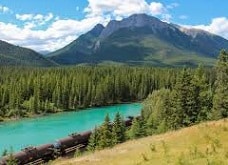In order to know the meaning of the term natural landscape, it is necessary, first of all, to discover the etymological origin of the two words that give it its name:
-Landscape, on the one hand, derives from French. Specifically, it is the result of the sum of two lexical components: the noun "pays", which means "field", and the suffix "-aje", which is used to indicate "set".
-Natural, on the other hand, comes from Latin. Exactly from the word "naturalis", which means "relative to nature" and which is the result of the sum of the following components: the adjective "natum", which is equivalent to "born"; the suffix "-ura", which indicates "result of the action", and the suffix "-al", which is used to establish "relative to".
The term landscape has several uses. At a general level it refers to a region or a sector of a territory that can be observed from a certain place or that stands out for its visual characteristics. Natural , meanwhile, is that which is characteristic of nature.
 An area that has not suffered major modifications by humans is called a natural landscape . Also mentioned as natural environment or natural space , the idea of natural landscape refers to places that present conditions and features that were not altered by man.
An area that has not suffered major modifications by humans is called a natural landscape . Also mentioned as natural environment or natural space , the idea of natural landscape refers to places that present conditions and features that were not altered by man.
The natural landscapes stand out for their low population density . Since not many people live on its surface , it does not have infrastructure development. That is, they do not have highways, large buildings, telephone antennas, etc. On the other hand, natural landscapes have their resources intact or, at least, well preserved.
It is important to establish that there are two different types of natural landscapes:
-The natural coastal landscape. As its name indicates, it is one that is near the sea.
-The inland natural landscape is, for its part, that which is identified because it is furthest from the coast. Within this type we can indicate that there are three different varieties: the interior landscape of the valley, the interior landscape of the plain and the interior landscape of the mountain.
It is possible to oppose a natural landscape to an ordered landscape . In a natural coastal landscape, for example, the sea reaches the beach without encountering ports, docks, docks or other structures. Furthermore, on the coast there are no buildings or human intervention. In an orderly landscape located in a similar region, there may be port works, spas , beach bars, waterfronts or boulevards and other developments.
Natural landscapes are very important on an ecological level . These are reservoirs of biodiversity that regulate the climate and that, due to their particularities, are usually protected through government provisions that prevent modification of the ecosystem. Nature reserves , natural monuments , national parks and protected landscapes are part of this type of land.
Furthermore, within the natural reserves we have to highlight the existence of two types: the integral natural reserves, which have ecosystems in an impeccable state of conservation, and the scientific natural reserves, which are those that, due to their elements or characteristics, have a undeniable scientific value.
